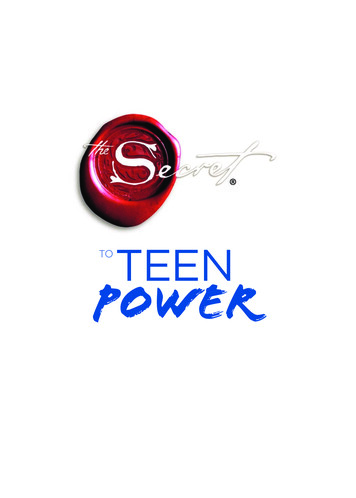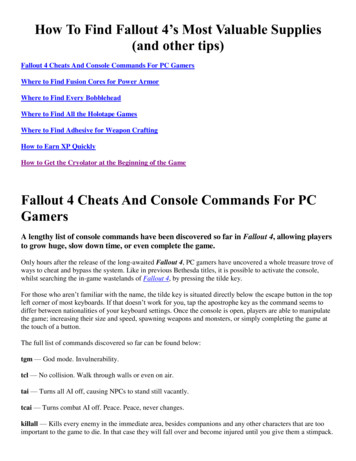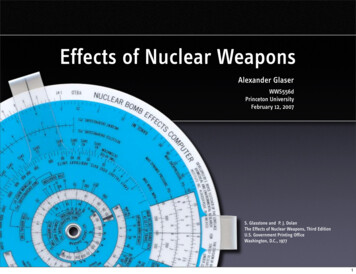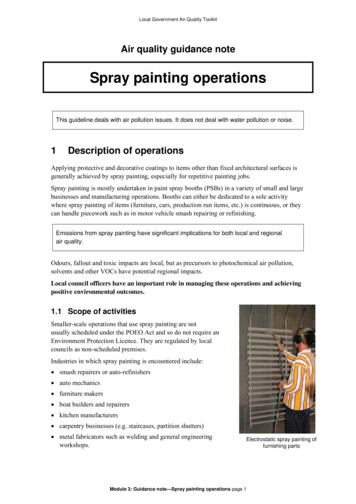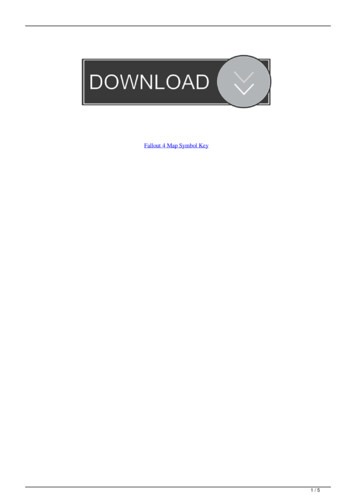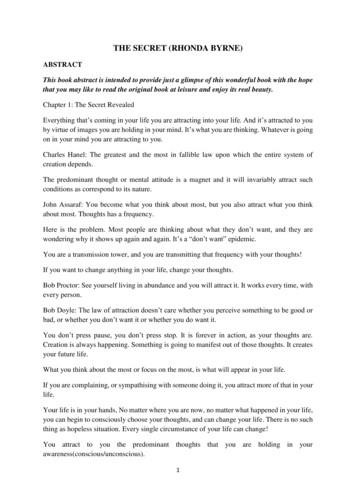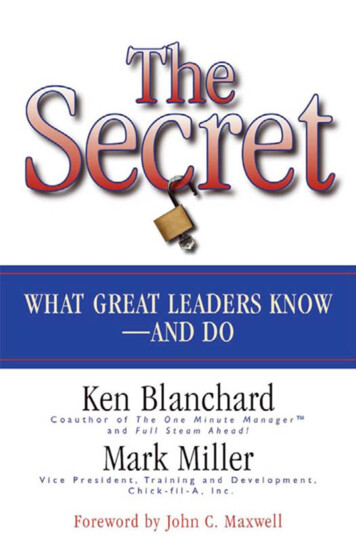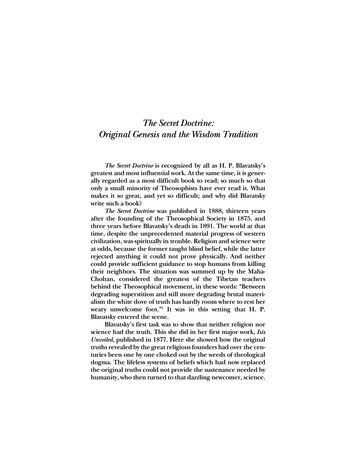
Transcription
SECRETFALLOUTLOW-LEVEL RADIATIONFROM HIROSHIMATO THREE-MILE ISLANDERNEST STERNGLASSIntroduction by George Wald
-2-"Professor Sternglass’s courageous voice has helped keep alive the debate on thehealth effects of low-level radiation, a debate that the military, the nuclearindustry, and even some biologists and physicians have tried to bury. His newbook, Secret Fallout: Low-Level Radiation from Hiroshima to Three Mile Island,is an important new contribution to that debate and should be required reading forall who are concerned with their own health, the health of their children, and oftheir children’s children."Victor W. Sidel, M.D.Professor and ChairpersonDepartment of Social MedicineMontefiore Hospital and Medical CenterAlbert Einstein College of MedicineDr. Ernest Sternglass is Professor of Radiology, specializing in radiologicalphysics, at the University of Pittsburgh Medical School, as well as AdjunctProfessor in the Department of History and Philosophy of Science at IndianaUniversity, Bloomington. He is past president of the Pittsburgh Chapter of theFederation of American Scientists, a Fellow of the American Physical Society, amember of the Radiological Society of North America and the AmericanAssociation of Physicists in Medicine. He has testified on low-level radiationbefore the Joint Committee on Atomic Energy and many other groups both hereand abroad.Dr. George Wald, Nobel Laureate in Physiology and Medicine, is Professor ofBiology at Harvard.
-3-Ernest J. SternglassSECRETFALLOUTLOW-LEVEL RADIATIONFROM HIROSHIMA TOTHREE MILE ISLANDMcGraw-Hill Book CompanyNew York St. Louis San FranciscoAuckland Bogota Guatemala HamburgJohannesburg Lisbon London Madrid MexicoMontreal New Delhi PanamaParis San Juan Sao Paulo Singapore Sydney Tokyo Toronto
-4-Copyright (c) 1972, 1981 by Ernest J. SternglassAll rights reserved. Printed in the United States of America. No part ofthis publication may be reproduced, stored in a retrieval system, ortransmitted, in any form or by any means, electronic, mechanical,photocopying, recording, or otherwise, without the prior writtenpermission of the publisher.This book is an expanded version of Low-Level Radiation, first publishedin 1972 by Ballantine Books.First McGraw-Hill Paperback edition, 19811 2 3 4 5 6 7 8 9 0 FGFG 8 6 5 4 3 2 1LIBRARY OF CONGRESS CATALOGING IN PUBLICATION DATASternglass, Ernest JSecret fallout.Ed. of 1972 published under title: Low-level radiation.Bibliography: p.Includes index.1. Radioactive pollution—Toxicology. 2. Radiation—ToxicologyI. Title. II. Title: Low-level radiation from Hiroshima to Three MileIsland.RA569.S69 1981616.9’89780-22390ISBN O-07-061242-0Book design by Roberta RezkThe author acknowledges the following sources for permission:The Washington Post for Bill Curry’s "A-Test Officials Feared Outcryafter Health Study."The New York Times for James Reston’s "The Present Danger." (c) 1978by The New York Times Company. Reprinted by permission.Harrowsmith Magazine for Tom Pawlick’s "The Silent Toll."Beaver County Times for Joel Griffiths’ "State Panel Questions,Radiation, Safety."
-5-The duty to enduregives us the right to know.—JEAN ROSTAND
-6-For Marilyn,and our childrenDaniel and Susan
nderstorm in TroyThe Unheeded WarningA Small Error in the AssumptionsA Ray of HopeThe Evidence Begins to EmergeThe Hidden Tragedy of HiroshimaDeath before BirthThe Crucial TestBoth Young and OldThe Clouds of TrinityThe Battle for PublicationCounterattack at HanfordThe Public’s Right to KnowThe Price of SecrecyFallout at ShippingportThe Minds of the ChildrenIncident at Three Mile IslandToo Little Information Too LateThe Present bliographyGlossaryIndex159171172
-8-AcknowledgmentsTHIS BOOK could not have come into being without the understanding, concern and support of manyindividuals whose help I was privileged to receive during the years in which the events recounted heretook place.Although it is impossible to list all those to whom I have become deeply indebted, there are a fewindividuals whose help went far beyond anything I shall ever be able to acknowledge adequately.First among these is my wife Marilyn, who not only stood by my side throughout these years, butalso provided the constant counsel, encouragement and understanding needed in the long and arduoustask of writing this book.And it was the great personal dedication of my editor, Joel Griffiths, that shaped the first edition ofthe book, helping immeasurably in the difficult task of explaining for the non-scientist the complexscientific and technical arguments underlying the events described. Thus, though the responsibilityfor the accuracy of the facts and their interpretation must remain mine, whatever success this bookmay have in clarifying the nature of the scientific problem and the dangers arising from the misuse ofnuclear radiation will be to a large extent a reflection of his efforts.Among the many others who contributed importantly to bringing this book into being, I mustexpress my indebtedness to Larry Bogart, long-time conservationist and founder of the NationalLeague to Stop Environmental Pollution, who together with Leo Goodman of the United AutomobileWorkers was responsible for first drawing my attention to the full hazard of an unchecked nucleartechnology.In these researches, I was greatly aided by two of my colleagues, Dr. Donald Sashin and RonaldRocchio, who worked out the computer programs that made the analysis of the vast amount ofstatistical data possible, as well as by Michael Szulman, Diane Gaye, Mitchel Margolis and DebbieConant, without whose dedication in patiently collecting and analyzing the data the task would havebeen insuperable.In the collection of the basic data, I was also generously helped by a number of young volunteerstudent assistants who spent long hours in the library. My gratitude goes to all of them, and inparticular to David and Harold Colker, Randolph Strothman, and Gary Harris, whose importantcontributions were particularly appreciated.Last but not least, I must express my deep appreciation to my secretary, Judy Czachowski, whopatiently suffered through the agonies of gathering the data, preparing papers and repeated retyping ofthe original manuscript, and without whose cheerful help and dedication the task would have beenvastly more difficult.The present, greatly expanded edition owes its existence to my new editor, Joanne Dolinar, whopersuaded me that it was important to tell the story of the developments in the ten years since thebook’s original publication. For her persistence in this I am deeply grateful. I am also grateful to mysecretary, Nancy Siegel, who greatly eased the task of completing the expanded version of the bookwith her unwavering patience in tackling the never-ending pages with their illegible revisions.
-9-PrefaceWHEN I UNDERTOOK to write the first edition of this book, originally published in 1972 under thetitle Low-Level Radiation, my primary concern was with the health effects of worldwide fallout fromnuclear weapons, particularly on the developing infant in the mother’s womb.At that time I also discussed the first evidence for possible health effects of routine releases ofradioactivity from nuclear reactors in their ordinary day-to-day operation.In the ten years that have intervened since then, my concerns about the safety of nuclear plantshave unfortunately been reinforced far more than I could have anticipated. Not only in the accident atThree Mile Island, whose likely effects on human health are discussed in the present book, but also inthe normal operations of many other nuclear plants, there is now growing evidence for rising infantmortality and damage to the newborn. In the decade that has passed, cancer rates increased mostsharply in areas closest to the nuclear reactors whose radioactive gas releases were found to rise moststrongly, following the earlier pattern of death rates among the newborn described in the originalbook.The first fourteen chapters have been left nearly unchanged, while the rest of the present bookbrings the story up to the present time. It deals with the newly disclosed evidence that the possibilityof serious health damage from weapons testing was long known to our government. It also presentsthe evidence for widespread damage to the learning abilities of the children born in areas of heavyfallout during the period of massive nuclear weapons testing.What emerges is that in order for major governments to be able to continue threatening the use oftheir ever-growing stockpiles of weapons to fight and win nuclear wars rather than merely to deterthem, they must keep from their own people the severity of the biological damage already done totheir children by past nuclear testing and the releases from nuclear reactors near their homes.It is to focus attention on the need to end this hidden threat to the future of human life on this globethat this new edition has been prepared.Ernest J. SternglassPittsburghJuly 1980
- 10 -IntroductionI SHOULD LIKE TO START with a few words concerning the human condition, and go on with alittle of the special problems of the author in writing this book.As a scientist I take a long view of history: 20 billion years of this universe; 6 billion years of thesolar system; 4.7 billion years of the planet Earth; 3 billion years of life on Earth; something like 3million years of something like human life; 10,000 years of civilization; and then—somethinghappened.In 1976 we celebrated the bicentennial of American independence. That independence was aninteresting event, but not nearly as important even to Americans as something else that was happeningat the same time. That was the Industrial Revolution. At first it promised humanity endless leisureand abundance. But a half-century ago it turned life-threatening on the grand scale; and now killingand destruction are the biggest business in the world. Military expenditures worldwide in 1979 wereover 460 billion, and rising rapidly. The simple reality is that a trivial two hundred years of theIndustrial Revolution have brought the human species to the brink of self-extinction.Nuclear war is the most immediate threat. Just the "strategic" nuclear weapons—the big ones, inthe megaton range1—now stockpiled by the U.S. and the Soviet Union add up to the explosiveequivalent of about 16 million tons of TNT. There are just over four billion persons on the Earth, soabout 4 tons of TNT for every man, woman and child in the world. In addition each superpower hasstored tens of thousands of so-called "tactical" nuclear weapons, and the material to make hundreds ofthousands more.So I had better say what a tactical nuclear weapon is. The bomb that in a moment leveled the cityof Hiroshima and by the end of that year—1945—had killed 140,000 persons rates in the presentarsenals as a pitifully small "tactical" weapon, a mere 12.5 kilotons. For comparison the Titan missilewhose fuel recently blew up in its silo in Arkansas had perhaps 100 times that explosive power.But the explosive power—the blast and heat and radiation—are just the immediate release ofnuclear weapons. There is also the mushroom cloud of radioactive fallout that enters the atmosphereand stratosphere and eventually covers the entire globe. This goes on showering the Earth withpotentially lethal ionizing radiation, and every rain and snowfall brings down radioactive elements tobe inhaled, and by entering the food chain, ingested. And that goes on and on, from thecomparatively short-lived iodine-131 and strontium-89, dangerous for 6 months to a year, toplutonium-239, perhaps the most toxic substance known, whose half-life—the time it takes for itsradioactivity to half-decay—is 24,400 years. That remains dangerous, in human terms, forever.hhhhhhhhhhhhhhhhhh1. Nuclear weapons are graded in terms of the equivalent explosive power in tons of TNT: kilotons, which are thousands of tons; or megatons, millionsof tons.
- 11 -An interesting dialogue taking place in the Atomic Scientists Bulletin raises the question: wouldanyone survive? If the present stockpiles of nuclear weapons were used, would any human beings beleft on the Earth? That is at least questionable, and we would take a lot of the rest of life on thisplanet with us.Directly out of the business of nuclear weapons came the business of nuclear power, heralded inour country with the slogan, Atoms for Peace. Even that innocent-sounding slogan is part of theendless pattern of public deception that surrounds the entire nuclear enterprise. Let me interject apresent example that poses the relationship nicely. In our country the entire hydrogen bombenterprise—both R and D and production—is not under the Department of Defense, but theDepartment of Energy. It goes, not into the Defense budget, but the Energy budget. It is by far thelargest item in that budget, consuming well over one-third of it. The next largest item in it is nuclearpower.Nuclear power and nuclear weapons are two sides of the same coin. Nuclear power is lifethreatening in three independent ways, each in itself formidable.First is the threat of accident in nuclear power plants. This book tells in some detail the story ofthe accident at Three Mile Island. But one didn’t have to wait for that to know that nuclear powerplants—unlike what the public has been told—are thoroughly accident-prone. Those great realists,the American insurance companies, refused from the beginning to insure nuclear power plants.Hence we have the Price-Anderson Act, renewed by Congress every 10 years since 1957, which laysthe bulk of the liability in the event of nuclear accident on "the government"—i.e., on the taxpayers.The second life-threatening property is that every nuclear reactor now in operation produces theartificial element plutonium-239 as by-product. This is not only, as already said, perhaps the mosttoxic substance known. It is also the most convenient material from which to make fission bombs.The "trigger quantity"—the smallest amount from which one can make a workable atom bomb—is 2kilograms, 4 2/5 pounds. You could carry that, and safely, in a grocery bag. To make a Hiroshimasize bomb would take 6-7 kilograms, say about 14 pounds. You’d need a shopping bag for that.Every nation that now possesses a nuclear reactor can, if it chooses, begin to make nuclear weapons.It is expected that within the coming decade perhaps a dozen more nations than now possess themwill exercise this option. It should be added that plutonium provides the trigger at the core of allhydrogen bombs, and in some also the shell.The third life-threatening aspect of both nuclear power and weapons involves the disposal ofnuclear wastes. No one knows what to do with them. The periodic meetings of international expertshave so far yielded no credible solution.In my opinion the entire nuclear enterprise, both power and weapons, represents a wrong turn forhumanity, a development that cannot be tamed, that remains life-threatening not only in all its presentmanifestations, but all future developments that have been contemplated.Meanwhile the public is subjected to a continuous barrage of propaganda and misinformationdesigned to reconcile it to an increasingly problematical and expensive support of both nuclear powerand weapons. The weapons, ostensibly for our security, are of course the principle source of ourinsecurity; and the nuclear power, that we are told we need for energy, supplies in 1980 only about12% of our consumption of electricity, hence only about 2% of our total energy consumption, at a stillunreckonable cost in both health and money.The author of such a book as this is under constant attack, not only from the expected sources inindustry and government, but from certain quarters in the science establishment. I have heard at timesfrom fellow scientists, some indeed on the same side as Professor Sternglass in opposing the spread ofionizing radiations, the somewhat querulous comment, "I don’t like his statistics." That wouldimpress me more if I had ever met anyone who liked anyone else’s statistics. That’s the way with
- 12 -statistics: they are highly individual. Sternglass has an exuberant way with them. At times in thisbook I had the feeling he was going a little far. But then I never could be sure, once I had read overcarefully what he was saying, that it was too far. The truth is that once one starts down this path, it’shard to know where or whether to stop. And on the fundamental issues, Sternglass is dealing with avery strong case. I think that it is by now beyond doubt that ionizing radiations at all levels involveserious risks to health, causing increased chances of cancers, leukemia and genetic effects. There isno threshold: a little, however little, causes some increased risk, and more causes more risk. There isno level that fails to be potentially harmful. From that point of view the existence of an official socalled "permissible level" is misleading. A "permissible level" of radiation only has meaning in costbenefit accounting; and that would mean more if the costs and benefits involved the same parties.Unfortunately they usually do not: one group—workers, general public—commonly bear the costs;and another, quite different group—ownership, management, government—shares the benefits.Having to deal with a lot of official talk about "permissible levels" of radiation at the time of ThreeMile Island, I took to saying, "Every dose is an overdose." I believe that to be true as a statement, notnecessarily of overt effect, but of risk.GEORGE WALDParis, October 28, 1980
- 13 -1Thunderstorm in TroyON MONDAY MORNING, April 27, 1953, the small group of students in Professor Herbert Clark’sradiochemistry class at Rensselaer Polytechnic Institute walked into the metal shack that served astheir laboratory, located high on a hill overlooking the city of Troy in upper New York State. Thestudents set about making preparations for the day’s experiments, but then Professor Clark interruptedto draw their attention to something unusual. All the Geiger counters were registering radiation atmany times the natural rate.Since instruments nearest the outer walls were giving the highest readings, several studentsimmediately went outside with a portable Geiger counter. At once they found that wherever theywalked, the count rate on the ground was far above normal, in some places a thousand times as high.In particular, beneath the spout of the gutters that carried the rainwater down off the roof of the shack,the needle gave a disconcertingly high reading. Evidently the previous night’s heavy rains hadbrought down large amounts of radioactivity.Dr. Clark quickly guessed the source. Such high readings could only have come from heavydeposits of fallout, the drifting clouds of radioactive debris created by the explosion of a nuclearbomb in the atmosphere. To verify his guess, he phoned John Harley, a friend and former colleaguewho now worked for the U.S. Atomic Energy Commission’s Health and Safety Laboratory in NewYork City. As one of Dr. Clark’s students recalled the story many years later, Harley’s first reactionwas that Clark must be kidding, and, expressing amused disbelief, he hung up. But a few minuteslater, New York called back. Dr. Clark summarized the details of the morning’s measurements: howthe count rate from the gamma radiation on the ground was anywhere from ten to five hundred timesnormal, how the activity from beta rays had gone up even more, and how "hot spots" beneathrainspouts and in puddles on the pavement showed still higher readings, much higher than he had everobserved after other nuclear tests, when it had been hard to measure any additional radioactivity at all.Thoroughly alarmed, the director of the New York Laboratory, Dr. Merrill Eisenbud, promised tocheck personally into the situation, to send some of his top people to make their own measurementson the spot, and to take any steps that might be called for to protect the public health.For, as Dr. Clark had just learned, there had indeed been a recent atomic bomb test, conducted bythe AEC in Nevada two days earlier. The bomb, code-named Simon and equivalent in power to43,000 tons of TNT, had been detonated in the atmosphere some 300 feet above the desert. The upperportion of the mushroom cloud had reached an altitude of about 30,000 or 40,000 feet and then drifted2300 miles across the United States in a northeasterly direction, passing high over Utah, Colorado,Kansas, Missouri, Illinois, Indiana, Ohio, and Pennsylvania before it encountered a severethunderstorm in progress over most of upstate New York, southern Vermont, and parts ofMassachusetts.The storm was an extraordinarily violent one, accompanied by extremely high winds, hail, and
- 14 -torrential rains that flooded streets and basements, undermined foundations, and caused heavy damageto trees and houses. It was one of the heaviest flash storms Dr. Clark could remember. The suddencloudburst, he surmised, had probably brought much of the fallout down in concentrated form. Dr.Clark quickly put his students to work in an effort to determine just how serious and widespread thedanger might be.Students set out with portable radiation detectors and began measuring the radioactivity on thepavement, on pieces of cloth, on asphalt roof shingles, on burdock leaves and other vegetation—anyplace it would be likely to collect and adhere. Samples were also taken of water from reservoirs andhousehold taps. Within a matter of hours the students were reporting back from such nearby townsand cities as Watervliet, Mechanicville, Saratoga Springs, Albany, and Schenectady that everywherethe radiation levels were about the same as on the campus. Typical readings were twenty to ahundred times normal, with hot spots up to ten times higher than that.Now knowing the radiation levels as well as the source and age of the fallout, Dr. Clark couldcalculate that during the next ten weeks the total gamma radiation dose to the population from theradioactivity in the environment would be, on the average, roughly equivalent to that received from atypical diagnostic X-ray exposure. This was reassuring, since such a dose was not very different fromwhat most people in the world receive each year from the naturally occurring cosmic rays thatpenetrate the earth’s atmosphere. And it was well below the maximum permissible dose limits set bygovernment agencies.However, there was also the high radioactivity in the rainwater, which was certain to contaminatethe reservoirs and thus the tap water. The samples of rainwater collected from a puddle on thecampus had shown a radioactivity level of 270,000 micromicrocuries per liter, thousands of timeshigher than the maximum levels then permitted by AEC standards, which were set at 100micromicrocuries per liter. Normal drinking water usually had an activity of about 1 micromicrocurieper liter.There was, accordingly, much apprehension among the students until the samples of actualdrinking water from the taps and reservoirs could be analyzed early the next day. When this wasdone, the first of the tap water samples, taken Monday night, showed an activity of 2630micromicrocuries per liter—not as great as was feared, yet still well in excess of the limit. But by thatevening, the same tap gave a sample with a greatly decreased activity of 1210 per liter, while samplesfrom nearby Tomhannock Reservoir ranged from 580 to 960. The radioactive rain was evidentlybecoming heavily diluted in the reservoir before reaching the taps in the households of Troy.Thus, all concerned were greatly relieved that the total radiation doses received by the populacewould probably turn out to be relatively small. It would not be necessary to filter the drinking wateror decontaminate the streets and rooftops by means of elaborate and costly scrubbing procedures, amonumental task in view of the tenacity with which the radioactivity had been found to cling to roughsurfaces such as pavement, asphalt shingles, and burdock leaves, and especially to porous materialslike paper and cloth. Dr. Clark and his students found that even treatment with hot, concentratedhydrochloric acid—an extreme method—was only partially effective in removing the radioactivityfrom the objects to which it clung. The class also conducted tests to determine the strength of thisradioactivity. Surprisingly, they found that it was comparable to that reported the previous year bythe AEC’s New York Laboratory for fallout in desert areas only 200 to 500 miles from the point ofdetonation at the Nevada test site itself.But the possible health effects of any internal doses that might result from eating, drinking, orbreathing the radioactivity were considered negligible by the New York State Health Department andthe AEC. And so it was decided that nothing further need be done. An editorial in the localnewspaper expressed some concern, but soon the whole incident was forgotten.
- 15 -Meanwhile, however, Dr. Clark, under contract to the AEC, continued to monitor the levels ofradioactivity in the reservoirs, while AEC physicists, using an extremely sensitive gamma-raydetector mounted in an airplane, conducted extensive surveys of the entire region. Detailed reports onthe findings were written by the staff of the New York Lab, but, since they were classified "secret,"the public never learned of their contents. All that appeared was the following brief statement in the14th Semi-Annual Report of the Atomic Energy Commission for the first half of 1953:After one detonation, unusually heavy fallout was noted as far from Nevada as the TroyAlbany area in New York. Following a heavy rain in that area on the second day after thedetonation, the concentration of radioactivity was from 100 to 200 curies per square mile. It isestimated that this level of radioactivity would result in about 0.1 roentgen exposure for thefirst 13 weeks following the fallout. The exposure has no significance in relation to health.One fact the AEC did not announce, and the general public did not learn, since it was laterpublished by Dr. Clark in the obscure, highly specialized Journal of the American Water WorksAssociation, was that, as the AEC continued its nuclear testing in Nevada during the spring of 1953,further rainouts repeatedly raised the radioactivity in the reservoirs serving Troy to levels comparableto those measured by Dr. Clark and his students the morning after the "Simon" rainout in April.
- 16 -2The Unheeded WarningTHE TROY INCIDENT was easily forgotten because, at the time, little was known about the effectsof low-level radiation—either from fallout or from other sources. The subject had hardly even beenthought about. Scientists generally assumed that such levels were harmless, since they produced noimmediately observable effects. During the next few years, however, tremendously improvedradiation measurement techniques coupled with detailed laboratory studies revealed many previouslyunsuspected hazards from fallout. And with these discoveries, the forgotten incident in upstate NewYork re-emerged and took on great significance.By 1953, it was already known that many of the radioactive elements (called isotopes) created byan atomic explosion, once they entered the atmosphere in the form of tiny fallout particles, wouldcontaminate food, water, and air and thus find their way into the human body. What was not widelyknown, however, was the extent to which these isotopes became concentrated in various body organs.Inside the body, they behaved just like their nonradioactive natural counterparts. The isotopestrontium, for instance, which is similar to calcium, settled in bones and teeth. Radioactive iodinebehaved like regular iodine, seeking out and concentrating in the thyroid gland, an organ which isvital in regulating the growth and functioning of the human body.It was in the case of iodine that some of the most alarming discoveries were made. In the early1950s researchers found that iodine became concentrated in the milk of cows that grazed on pasturecontaminated with fallout. When people drank the milk, the iodine began building up rapidly in theirthyroid glands. Since the thyroid gland is small in size, the concentration was very heavy.Measurements revealed that in any given situation the radiation dose to the adult thyroid would be asmuch as a hundred times the external dose from the fallout in the outside environment. But far moreimportant were the results of extensive studies conducted at the University of Michigan and publishedin 1960. These showed that the radiation dose to the thyroids of unborn children and infants was tento one hundred times higher than that to the adult because of the greater concentration in the smallerthyroids. This discovery held serious implications for the health of the children of Troy. It meant thatthe doses to their thyroids might have been as much as a hundred to a thousand times higher thanthose estimated by Dr. Clark and the AEC scientists, who had only considered the overall dose fromthe fallout in the external environment.However, by the time these discoveries became widely known, a voluntary halt in atmospherictesting had been agreed upon by the Soviet Union, the United States, and Great Britain, and there wasconsiderable hope that incidents of heavy fallout would never occur again. Thus it seemed less urgentto pursue investigations into the problem. But in 1961, during the Berlin crisis, Russia’s detonation ofa 100-megaton hydrogen bomb high over Siberia marked the resumption of large-scale atmospherictesting by the nuclear powers, and the levels of radioactivity in air and water once again rose sharplythroughout the world. In the weeks that followed, an enormous peak
book, Secret Fallout: Low-Level Radiation from Hiroshima to Three Mile Island, . the book, helping immeasurably in the difficult task of explaining for the non-scientist the complex . and destruction are the biggest business in the world. Military expenditures worldwide in 1979 were over 460 billion, and rising rapidly. The simple reality .
